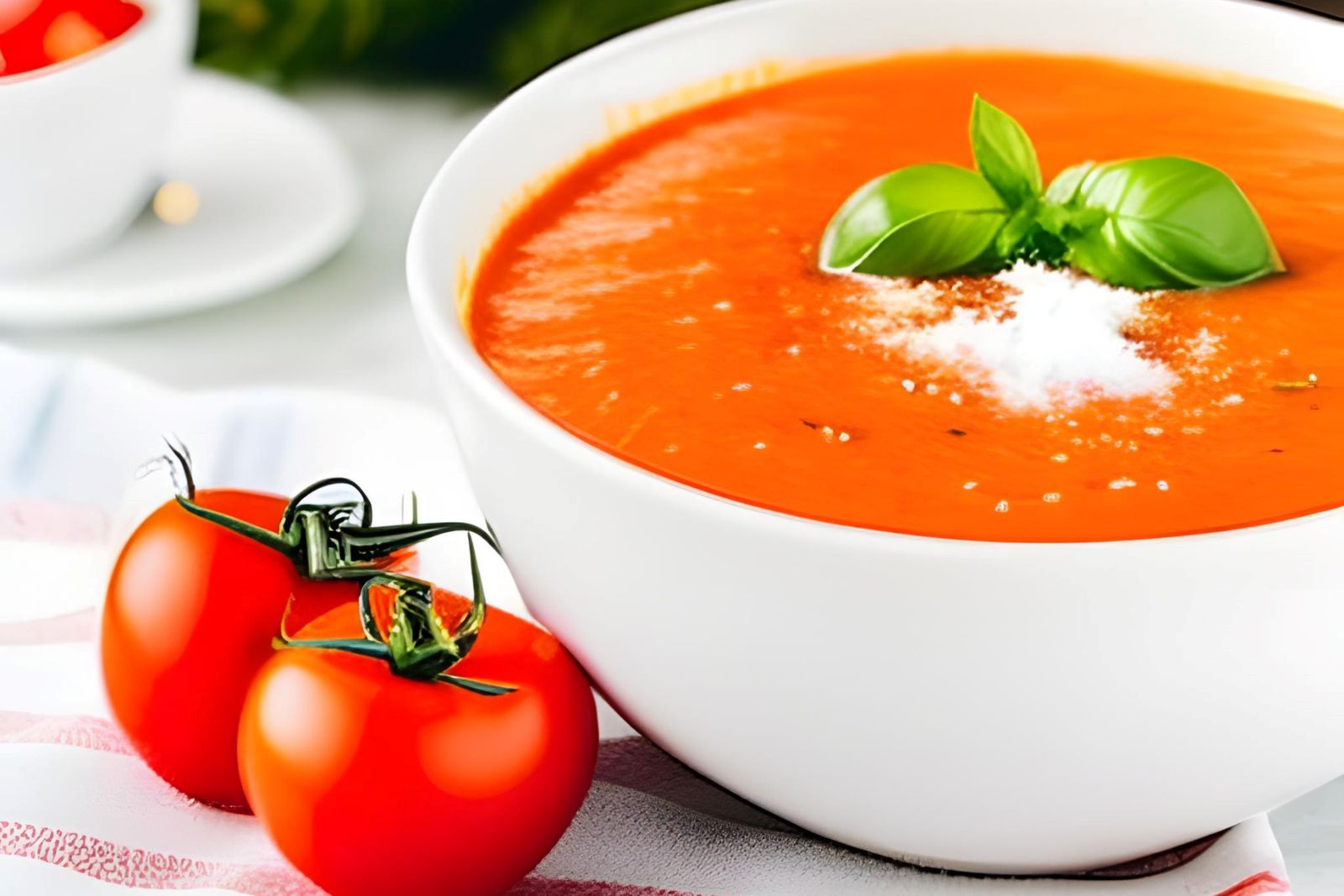
Tomato soup is a beloved dish that’s perfect for cozy winter nights or even a light summer lunch. Whether you’ve made a large batch or have some leftovers, freezing tomato soup is a great way to preserve its freshness and flavor for later. Freezing tomato soup is a simple process, but it’s important to follow the right steps to ensure that it retains its taste and texture. In this article, we’ll provide a step-by-step guide on how to freeze tomato soup so you can enjoy this comforting dish year-round.
Here are the simple steps to freeze tomato soup:
Step 1: Cool the Tomato Soup
Cooling the tomato soup is an important step in the freezing process to maintain its quality. When the hot soup is placed directly in the freezer, it can develop ice crystals and unevenly freeze, leading to changes in texture and taste.
To cool the soup, start by removing it from the heat source. Allow it to rest at room temperature for about 30 minutes to release excess heat. This helps prevent condensation from forming inside the storage container.
Alternatively, if you want to cool the soup more quickly, you can place the pot or container in an ice bath. Fill a larger bowl or sink with cold water and ice cubes. Set the pot of soup in the ice bath and stir occasionally to speed up the cooling process. Once the soup has reached room temperature, you can proceed to the next step.
Another option is to transfer the pot of soup to the refrigerator and let it cool for a few hours. This method is particularly useful if you have a large batch of soup or if you’re planning to store the soup for an extended period before freezing. The refrigerator’s controlled temperature ensures gradual cooling and helps maintain the soup’s flavors.
By ensuring the soup is thoroughly cooled, you promote even freezing and minimize the risk of freezer burn or a grainy texture. Take your time with this step to ensure the best results when freezing tomato soup.
Step 2: Choose the Right Container
Selecting the right containers for freezing tomato soup is essential to preserve its flavor, texture, and prevent any potential leaks or freezer burn. When choosing containers, opt for ones that are specifically labeled as freezer-safe. Here are some suitable options:
- Freezer-safe plastic containers: Look for containers made from sturdy, BPA-free plastic that can withstand low temperatures. Choose containers with a tight-fitting lid to ensure an airtight seal.
- Mason jars: Glass jars with airtight lids, such as Mason jars, can be a great choice for freezing tomato soup. Make sure to leave sufficient headspace at the top to accommodate expansion during freezing.
- Freezer bags: Heavy-duty, zip-top freezer bags can be a convenient option, especially if you want to save space in your freezer. Use freezer bags that are specifically designed for freezing to prevent any leaks.
Regardless of the container you choose, make sure it is clean and dry before transferring the cooled soup. Ensure that the lids or closures are securely fastened to maintain an airtight seal. Leaving some headspace at the top is important as the soup will expand when it freezes.
Proper containers help to protect the soup from exposure to air and moisture, minimizing the risk of freezer burn. They also make it easier to stack and organize the soup in the freezer. By selecting the right containers, you can preserve the quality of the tomato soup during the freezing process.
Step 3: Portion and Label the Tomato Soup
Portioning and labeling the tomato soup before freezing not only allows for convenient usage but also helps you keep track of its freshness and contents.
Start by determining the portion sizes that suit your needs. Consider how much soup you typically consume in one serving or meal. Dividing the soup into individual or family-sized portions will enable you to thaw and use only what you need without having to defrost the entire batch.
Next, transfer the cooled soup into the chosen containers, leaving enough space at the top to account for expansion during freezing. Seal the containers tightly to maintain freshness and prevent any leakage.
Label each container with essential information, such as the date of freezing and the contents. This step is crucial for organizing your frozen tomato soup and keeping track of its storage time. Use a permanent marker or labels that adhere well to the containers, ensuring the information remains intact even in the freezer’s low temperatures.
Clear labeling helps you identify the soup easily and enables you to prioritize consuming the oldest batches first. It also allows you to monitor the soup’s storage duration, ensuring you consume it within recommended timeframes for optimal quality and safety.
By portioning and labeling the tomato soup before freezing, you streamline the process of thawing and avoid wastage, ensuring a convenient and well-organized freezer stock of delicious tomato soup.
Step 4: Freeze the Tomato Soup
After portioning and labeling the tomato soup, it’s time to transfer the containers to the freezer. Follow these steps to ensure proper freezing:
- Arrange in a single layer: Place the containers in a single layer in the freezer. This allows for even airflow and promotes quick freezing. If you have limited space, you can stack the containers once the soup is completely frozen.
- Avoid freezer door: Keep the containers away from the freezer door. The door is frequently opened and closed, causing temperature fluctuations. Placing the soup containers closer to the back of the freezer ensures a more consistent temperature, promoting optimal freezing.
- Allow sufficient freezing time: The soup needs sufficient time to freeze thoroughly. The exact time will depend on the volume and thickness of the soup. As a general guideline, it may take several hours overnight for the soup to freeze completely. Check the containers periodically to ensure they are frozen solid before proceeding to the next step.
Proper freezing is crucial to maintain the quality of the tomato soup. It prevents the formation of ice crystals, which can cause texture changes and affect the taste. By arranging the containers in a single layer and avoiding temperature fluctuations, you ensure the soup freezes evenly and retains its flavors.
Step 5: Thaw and Reheat the Tomato Soup
Thawing and reheating frozen tomato soup correctly ensures both safety and optimal taste. Follow these guidelines to thaw and reheat the soup:
- Refrigerator thawing: The best method for thawing frozen tomato soup is to transfer the container from the freezer to the refrigerator. Place the sealed container in the refrigerator and allow it to thaw slowly overnight or for several hours. This gradual thawing process maintains the soup’s texture and flavor while preventing bacterial growth.
- Cold water thawing: If you need to thaw the soup more quickly, you can use the cold water thawing method. Ensure the container is tightly sealed and submerge it in a bowl of cold water. Change the water every 30 minutes to maintain a consistent temperature. With this method, the soup should thaw in a couple of hours, depending on the container’s size and thickness of the soup.
- Avoid room temperature thawing: It’s essential to avoid thawing tomato soup at room temperature. This can create an environment that promotes bacterial growth and foodborne illnesses. Rapid temperature changes can also affect the soup’s quality. Therefore, it’s best to stick to refrigerator thawing or cold water thawing methods.
By following these guidelines, you can safely thaw and reheat your frozen tomato soup, bringing it back to its delicious, piping-hot state. Enjoy your homemade soup with the same flavors and textures as when it was freshly made.
Other related questions
How long can tomato soup last in the freezer?
Tomato soup can last in the freezer for up to 4-6 months if stored properly in an airtight and freezer-safe container. However, for the best quality and flavor, it’s recommended to consume the frozen soup within 2-3 months of freezing. Over time, frozen food can develop freezer burn and lose some of its flavor and texture.
It’s important to label the container with the date that the soup was frozen, so you can keep track of how long it has been stored in the freezer. If the soup appears to have freezer burn or an off flavor or smell when you thaw it, it’s best to discard it and not consume it.
Can you refreeze tomato soup?
Refreezing tomato soup is not recommended as it can affect the safety and quality of the soup. When you thaw frozen tomato soup, bacteria may start to grow and multiply, and refreezing the soup can allow the bacteria to continue to grow even at freezing temperatures. Additionally, the texture and flavor of the soup can be negatively affected by the freezing and thawing process, especially if the soup has already been reheated once.
How do I know if the tomato soup has gone bad after being frozen?
When determining if frozen tomato soup has gone bad, there are a few indicators to consider. Firstly, check for any off smells or foul odors emanating from the soup, as it could indicate spoilage. Additionally, inspect the soup for unusual texture changes such as graininess, separation, or discoloration. Lastly, if there are signs of mold growth or if the soup tastes sour or unpleasant, it is best to discard it to ensure food safety.
Can I freeze tomato soup that has cream or milk in it?
Yes, you can freeze tomato soup that has cream or milk in it, but the texture may change slightly after freezing. When reheating, stir the soup well to recombine the ingredients. It’s important to note that soups with cream or milk may separate after freezing, so they may not have the same smooth texture as before freezing.
Can I freeze tomato soup with meat in it?
Yes, you can freeze tomato soup with meat in it, but make sure that the meat is fully cooked before adding it to the soup. When reheating, make sure that the soup reaches a safe temperature of 165°F (74°C) to ensure that any bacteria in the meat is killed. It’s important to note that meat may become slightly tougher after freezing, but the flavor should not be affected.
How long can tomato soup be stored in the refrigerator before freezing?
Tomato soup can be stored in the refrigerator for up to 3-4 days before freezing. Make sure to cool the soup to room temperature before transferring it to the refrigerator to prevent bacterial growth. If the soup has been sitting out at room temperature for more than 2 hours, it should not be stored in the refrigerator and should be discarded instead.
Can I flash-freeze tomato soup?
Flash-freezing tomato soup is a method used to quickly freeze the soup at extremely low temperatures, preserving its quality. However, flash freezing is typically performed using specialized equipment, such as liquid nitrogen or blast freezers, which may not be readily available in a home kitchen. While it is possible to achieve a similar effect by spreading the soup in a thin layer on a baking sheet and placing it in the freezer, this method is not as efficient as true flash freezing.








